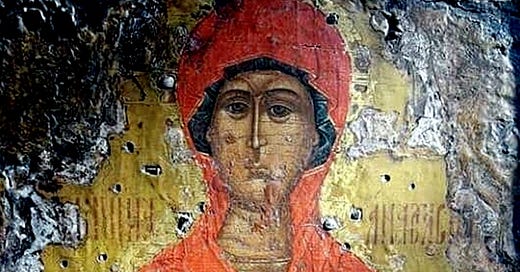Holy Great Martyr Anastasia, a native of Rome, suffered for Christ during the persecution of Diocletian. Her father was a pagan, and her mother was a secret Christian. In her youth, Saint Anastasia was taught by Chrysogon, a pious and educated Christian. After the death of his wife, her father gave Saint Anastasia in marriage to the pagan Pompeius, but under the pretext of a fictitious illness, she preserved her virginity.
Dressed as a beggar and accompanied only by a single maid, she visited prisons: feeding, healing, and often ransoming prisoners who suffered for their faith in Christ. When the maid revealed everything to Pompeius, he subjected his wife to tortures and confined her at home. Then Saint Anastasia began to secretly correspond with Chrysogon, who urged her to arm herself with patience, to cling with all her thoughts to the Cross of Christ, preparing herself for service to the Lord, and predicted the imminent death of Pompeius at sea. Sometime later, while on a mission to Persia, Pompeius indeed drowned. After her husband's death, Saint Anastasia generously distributed her wealth to the poor and the suffering.
Diocletian was informed that Christians, filling the prisons of Rome, stoically endured tortures. He then ordered all of them to be killed in one night, and Chrysogon to be brought to him in Aquileia. Saint Anastasia followed her teacher from afar.
The Emperor personally interrogated Chrysogon but, unable to make him renounce his faith, ordered his head to be cut off and thrown into the sea. The body and severed head of the holy martyr were washed ashore. A certain presbyter Zoiil found them by divine revelation, placed them in a coffin, and hid them in his house. Then Saint Chrysogon appeared to Zoiil and revealed to him the impending martyrdom of Agapia, Chionia, and Irene - young Christian women living nearby - and instructed him to send Saint Anastasia to them. To Zoiil himself, Chrysogon predicted a peaceful death. In a vision, Chrysogon also showed Saint Anastasia the way to Zoiil. Arriving at the presbyter, she prayed at the relics of Saint Chrysogon, and then spiritually strengthened the three maidens before their tortures. When the martyrs gave up their souls to the Lord, she herself buried them.
Having fulfilled her teacher's will, Saint Anastasia began to wander. Having mastered the art of healing, she zealously served prisoners everywhere. By her many labors, Saint Anastasia earned the name Deliverer, as she released many confessors of Christ from the heavy bonds of long-term suffering.
She once met a pious young widow, Theodotia, and found in her a faithful helper. Soon both were persecuted. Saint Anastasia was captured while in Illyria. After Diocletian ordered all Christian prisoners to be killed in one night, Saint Anastasia came to one of the prisons and, finding no one there, began to weep loudly. The jailers realized she was a Christian and took her to the regional governor, who tried to persuade her to renounce Christ, threatening tortures, and then handed her over to the Capitoline priest Ulpian. The cunning priest offered Saint Anastasia a choice between luxury and wealth, or severe sufferings, placing before her gold, precious stones, and clothes on one side, and terrifying instruments of torture on the other. The pagan deceit was shamed by the bride of Christ - Saint Anastasia rejected the wealth and chose the instruments of torture. But the Lord prolonged her earthly journey. Wounded by Anastasia's beauty, the priest decided to defile her purity, but at his first attempt to touch her, he suddenly went blind. Driven mad by pain, he ran to the pagan temple, crying to the idols for help, but fell on the way and died. Saint Anastasia was freed and, together with Theodotia, again dedicated herself to serving suffering Christians. Soon Saint Theodotia and her three sons suffered martyrdom. Her eldest son Evod bravely faced the judge and meekly endured beatings. After long tortures, they were all thrown into a heated furnace.
Saint Anastasia was captured again and sentenced to starve to death. She spent 60 days in prison without food. Every night, Saint Theodotia appeared to her and strengthened her. Seeing that hunger did not harm Saint Anastasia, the judge ordered her to be drowned along with condemned criminals. Among these people was Eutychian, persecuted for the Christian faith.
When the ship went out to sea, the soldiers drilled holes in it and moved into a boat. Saint Theodotia appeared to the prisoners and led the ship to shore. Going ashore, 120 miraculously saved people believed in Christ and were baptized by Saints Anastasia and Eutychian. Soon all were captured and given over to martyrdom. Saint Anastasia was crucified between four pillars above a kindled fire. Her body, unharmed by fire, was buried by a pious woman, Apollinaria, in a garden. In the 5th century, the relics of Saint Anastasia were transferred to Constantinople, where a church was built in her name. Later, the head and right hand of the great martyr were transferred to the monastery of Saint Anastasia the Deliverer, created near Mount Athos.



